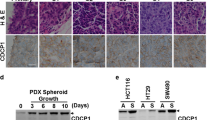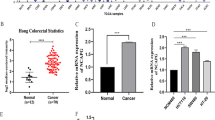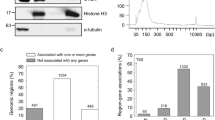Abstract
S100A4 promotes metastasis in several types of cancer, but the involved molecular mechanisms are still incompletely described. The protein is associated with a wide variety of biological functions and it locates to different subcellular compartments, including nuclei, cytoplasm and extracellular space. Nuclear expression of S100A4 has been associated with more advanced disease stage as well as poor outcome in colorectal cancer (CRC). The present study was initiated to investigate the nuclear function of S100A4 and thereby unravel potential biological mechanisms linking nuclear expression to a more aggressive phenotype. CRC cell lines show heterogeneity in nuclear S100A4 expression and preliminary experiments revealed cells in G2/M to have increased nuclear accumulation compared to G1 and S cells, respectively. Synchronization experiments validated nuclear S100A4 expression to be most prominent in the G2/M phase, but manipulating nuclear levels of S100A4 using lentiviral modified cells failed to induce changes in cell cycle distribution and proliferation. Proximity ligation assay did, however, demonstrate proximity between S100A4 and cyclin B1 in vitro, while confocal microscopy showed S100A4 to localize to areas corresponding to centrosomes in mitotic cells prior to chromosome segregation. This might indicate a novel and uncharacterized function of the metastasis-associated protein in CRC cells.





Similar content being viewed by others
References
Donato R (2003) Intracellular and extracellular roles of S100 proteins. Microsc Res Tech 60(6):540–551. doi:10.1002/jemt.10296
Heizmann CW (2002) The multifunctional S100 protein family. Methods Mol Biol 172:69–80. doi:10.1385/1-59259-183-3:069
Marenholz I, Lovering RC, Heizmann CW (2006) An update of the S100 nomenclature. Biochim Biophys Acta 1763(11):1282–1283. doi:10.1016/j.bbamcr.2006.07.013
Malashkevich VN, Varney KM, Garrett SC, Wilder PT, Knight D, Charpentier TH, Ramagopal UA, Almo SC, Weber DJ, Bresnick AR (2008) Structure of Ca2+-bound S100A4 and its interaction with peptides derived from nonmuscle myosin-IIA. Biochemistry 47(18):5111–5126. doi:10.1021/bi702537s
Helfman DM, Kim EJ, Lukanidin E, Grigorian M (2005) The metastasis associated protein S100A4: role in tumour progression and metastasis. Br J Cancer 92(11):1955–1958. doi:10.1038/sj.bjc.6602613
Flatmark K, Pedersen KB, Nesland JM, Rasmussen H, Aamodt G, Mikalsen SO, Bjornland K, Fodstad O, Maelandsmo GM (2003) Nuclear localization of the metastasis-related protein S100A4 correlates with tumour stage in colorectal cancer. J Pathol 200(5):589–595. doi:10.1002/path.1381
Ilg EC, Schafer BW, Heizmann CW (1996) Expression pattern of S100 calcium-binding proteins in human tumors. Int J Cancer J Int Cancer 68(3):325–332. doi:10.1002/(sici)1097-0215(19961104)68:3
Takenaga K, Nakamura Y, Endo H, Sakiyama S (1994) Involvement of S100-related calcium-binding protein pEL98 (or mts1) in cell motility and tumor cell invasion. Japn J Cancer Res 85(8):831–839
Gongoll S, Peters G, Mengel M, Piso P, Klempnauer J, Kreipe H, von Wasielewski R (2002) Prognostic significance of calcium-binding protein S100A4 in colorectal cancer. Gastroenterology 123(5):1478–1484
Boye K, Nesland JM, Sandstad B, Maelandsmo GM, Flatmark K (2010) Nuclear S100A4 is a novel prognostic marker in colorectal cancer. Eur J Cancer 46(16):2919–2925. doi:10.1016/j.ejca.2010.07.013
Hanahan D, Weinberg RA (2000) The hallmarks of cancer. Cell 100(1):57–70
Galderisi U, Jori FP, Giordano A (2003) Cell cycle regulation and neural differentiation. Oncogene 22(33):5208–5219. doi:10.1038/sj.onc.1206558
Nigg EA (1995) Cyclin-dependent protein kinases: key regulators of the eukaryotic cell cycle. BioEssays 17(6):471–480. doi:10.1002/bies.950170603
Hollstein M, Rice K, Greenblatt MS, Soussi T, Fuchs R, Sorlie T, Hovig E, Smith-Sorensen B, Montesano R, Harris CC (1994) Database of p53 gene somatic mutations in human tumors and cell lines. Nucleic Acids Res 22(17):3551–3555
Vogelstein B, Lane D, Levine AJ (2000) Surfing the p53 network. Nature 408(6810):307–310. doi:10.1038/35042675
Kastan MB, Onyekwere O, Sidransky D, Vogelstein B, Craig RW (1991) Participation of p53 protein in the cellular response to DNA damage. Cancer Res 51(23 Pt 1):6304–6311
Fukasawa K, Choi T, Kuriyama R, Rulong S, Vande Woude GF (1996) Abnormal centrosome amplification in the absence of p53. Science 271(5256):1744–1747
Goodarzi AA, Noon AT, Deckbar D, Ziv Y, Shiloh Y, Lobrich M, Jeggo PA (2008) ATM signaling facilitates repair of DNA double-strand breaks associated with heterochromatin. Mol Cell 31(2):167–177. doi:10.1016/j.molcel.2008.05.017
Brunton H, Goodarzi AA, Noon AT, Shrikhande A, Hansen RS, Jeggo PA, Shibata A (2011) Analysis of human syndromes with disordered chromatin reveals the impact of heterochromatin on the efficacy of ATM-dependent G2/M checkpoint arrest. Mol Cell Biol 31(19):4022–4035. doi:10.1128/mcb.05289-11
Xu B, Kim S, Kastan MB (2001) Involvement of Brca1 in S-phase and G(2)-phase checkpoints after ionizing irradiation. Mol Cell Biol 21(10):3445–3450. doi:10.1128/mcb.21.10.3445-3450.2001
Chen J (2000) Ataxia telangiectasia-related protein is involved in the phosphorylation of BRCA1 following deoxyribonucleic acid damage. Cancer Res 60(18):5037–5039
Canman CE, Lim DS, Cimprich KA, Taya Y, Tamai K, Sakaguchi K, Appella E, Kastan MB, Siliciano JD (1998) Activation of the ATM kinase by ionizing radiation and phosphorylation of p53. Science 281(5383):1677–1679
Hartwell L (1992) Defects in a cell cycle checkpoint may be responsible for the genomic instability of cancer cells. Cell 71(4):543–546
Ashwell S, Zabludoff S (2008) DNA damage detection and repair pathways–recent advances with inhibitors of checkpoint kinases in cancer therapy. Clin Cancer Res 14(13):4032–4037. doi:10.1158/1078-0432.ccr-07-5138
el Bahassi M, Myer DL, McKenney RJ, Hennigan RF, Stambrook PJ (2006) Priming phosphorylation of Chk2 by polo-like kinase 3 (Plk3) mediates its full activation by ATM and a downstream checkpoint in response to DNA damage. Mutat Res 596(1–2):166–176. doi:10.1016/j.mrfmmm.2005.12.002
Longshaw VM, Chapple JP, Balda MS, Cheetham ME, Blatch GL (2004) Nuclear translocation of the Hsp70/Hsp90 organizing protein mSTI1 is regulated by cell cycle kinases. J Cell Sci 117(Pt 5):701–710. doi:10.1242/jcs.00905
Muslin AJ, Xing H (2000) 14-3-3 proteins: regulation of subcellular localization by molecular interference. Cell Signal 12(11–12):703–709
Gavet O, Pines J (2010) Activation of cyclin B1-Cdk1 synchronizes events in the nucleus and the cytoplasm at mitosis. J Cell Biol 189(2):247–259. doi:10.1083/jcb.200909144
Caldas H, Jiang Y, Holloway MP, Fangusaro J, Mahotka C, Conway EM, Altura RA (2005) Survivin splice variants regulate the balance between proliferation and cell death. Oncogene 24(12):1994–2007. doi:10.1038/sj.onc.1208350
Gorsler T, Murzik U, Ulbricht T, Hentschel J, Hemmerich P, Melle C (2010) DNA damage-induced translocation of S100A11 into the nucleus regulates cell proliferation. BMC Cell Biol 11:100. doi:10.1186/1471-2121-11-100
Cajone F, Sherbet GV (1999) Stathmin is involved in S100A4-mediated regulation of cell cycle progression. Clin Exp Metastasis 17(10):865–871
Parker C, Whittaker PA, Usmani BA, Lakshmi MS, Sherbet GV (1994) Induction of 18A2/mts1 gene expression and its effects on metastasis and cell cycle control. DNA Cell Biol 13(10):1021–1028
Ismail TM, Fernig DG, Rudland PS, Terry CJ, Wang G, Barraclough R (2008) The basic C-terminal amino acids of calcium-binding protein S100A4 promote metastasis. Carcinogenesis 29(12):2259–2266. doi:10.1093/carcin/bgn217
Li ZH, Dulyaninova NG, House RP, Almo SC, Bresnick AR (2010) S100A4 regulates macrophage chemotaxis. Mol Biol Cell 21(15):2598–2610. doi:10.1091/mbc.E09-07-0609
Mendez J, Stillman B (2000) Chromatin association of human origin recognition complex, cdc6, and minichromosome maintenance proteins during the cell cycle: assembly of prereplication complexes in late mitosis. Mol Cell Biol 20(22):8602–8612
Flatmark K, Maelandsmo GM, Mikalsen SO, Nustad K, Varaas T, Rasmussen H, Meling GI, Fodstad O, Paus E (2004) Immunofluorometric assay for the metastasis-related protein S100A4: release of S100A4 from normal blood cells prohibits the use of S100A4 as a tumor marker in plasma and serum. Tumour Biol 25(1–2):31–40. doi:10.1159/000077721
Stathis A, Oza A (2010) Targeting wee1-like protein kinase to treat cancer. Drug News Perspect 23(7):425–429. doi:10.1358/dnp.2010.23.7.1490760
de Carcer G, Perez de Castro I, Malumbres M (2007) Targeting cell cycle kinases for cancer therapy. Curr Med Chem 14(9):969–985
Charrier-Savournin FB, Chateau MT, Gire V, Sedivy J, Piette J, Dulic V (2004) p21-Mediated nuclear retention of cyclin B1-Cdk1 in response to genotoxic stress. Mol Biol Cell 15(9):3965–3976. doi:10.1091/mbc.E03-12-0871
Wang Y, Ji P, Liu J, Broaddus RR, Xue F, Zhang W (2009) Centrosome-associated regulators of the G(2)/M checkpoint as targets for cancer therapy. Mol Cancer 8:8. doi:10.1186/1476-4598-8-8
Jackman M, Lindon C, Nigg EA, Pines J (2003) Active cyclin B1-Cdk1 first appears on centrosomes in prophase. Nat Cell Biol 5(2):143–148. doi:10.1038/ncb918
Zhang T, Woods TL, Elder JT (2002) Differential responses of S100A2 to oxidative stress and increased intracellular calcium in normal, immortalized, and malignant human keratinocytes. J Invest Dermatol 119(5):1196–1201. doi:10.1046/j.1523-1747.2002.19520.x
Murzik U, Hemmerich P, Weidtkamp-Peters S, Ulbricht T, Bussen W, Hentschel J, von Eggeling F, Melle C (2008) Rad54B targeting to DNA double-strand break repair sites requires complex formation with S100A11. Mol Biol Cell 19(7):2926–2935. doi:10.1091/mbc.E07-11-1167
Bao L, Odell AF, Stephen SL, Wheatcroft SB, Walker JH, Ponnambalam S (2012) The S100A6 calcium-binding protein regulates endothelial cell-cycle progression and senescence. FEBS J 279(24):4576–4588. doi:10.1111/febs.12044
Sorci G, Agneletti AL, Bianchi R, Donato R (1998) Association of S100B with intermediate filaments and microtubules in glial cells. Biochim Biophys Acta 1448(2):277–289
Grigorian M, Lukanidin E (2003) Activator of metastasis in cancer cells, Mst1/S100A4 protein binds to tumor suppressor protein p53. Genetika 39(7):900–908
Orre LM, Panizza E, Kaminskyy VO, Vernet E, Graslund T, Zhivotovsky B, Lehtio J (2013) S100A4 interacts with p53 in the nucleus and promotes p53 degradation. Oncogene 32(49):5531–5540. doi:10.1038/onc.2013.213
Berge G, Costea DE, Berg M, Rasmussen H, Grotterod I, Lothe RA, Maelandsmo GM, Flatmark K (2011) Coexpression and nuclear colocalization of metastasis-promoting protein S100A4 and p53 without mutual regulation in colorectal carcinoma. Amino Acids 41(4):875–884. doi:10.1007/s00726-010-0514-6
Scotto C, Delphin C, Deloulme JC, Baudier J (1999) Concerted regulation of wild-type p53 nuclear accumulation and activation by S100B and calcium-dependent protein kinase C. Mol Cell Biol 19(10):7168–7180
Mueller A, Schafer BW, Ferrari S, Weibel M, Makek M, Hochli M, Heizmann CW (2005) The calcium-binding protein S100A2 interacts with p53 and modulates its transcriptional activity. J Biol Chem 280(32):29186–29193. doi:10.1074/jbc.M505000200
Innocente SA, Abrahamson JL, Cogswell JP, Lee JM (1999) p53 regulates a G2 checkpoint through cyclin B1. Proc Natl Acad Sci USA 96(5):2147–2152
Myklebust MP, Li Z, Tran TH, Rui H, Knudsen ES, Elsaleh H, Fluge O, Vonen B, Myrvold HE, Leh S, Tveit KM, Pestell RG, Dahl O (2012) Expression of cyclin D1a and D1b as predictive factors for treatment response in colorectal cancer. Br J Cancer 107(10):1684–1691. doi:10.1038/bjc.2012.463
Fluge O, Gravdal K, Carlsen E, Vonen B, Kjellevold K, Refsum S, Lilleng R, Eide TJ, Halvorsen TB, Tveit KM, Otte AP, Akslen LA, Dahl O (2009) Expression of EZH2 and Ki-67 in colorectal cancer and associations with treatment response and prognosis. Br J Cancer 101(8):1282–1289. doi:10.1038/sj.bjc.6605333
Acknowledgments
We would like to thank Stein Waagene for carrying out the animal experiments and Dr. Vivi Ann Flørenes for valuable feedback and discussion. The present work was kindly supported by the Norwegian Cancer Society (Grant No [#4218523581] to EVE).
Author information
Authors and Affiliations
Corresponding authors
Ethics declarations
Conflict of interest
The authors declare that they have no conflict of interest.
Electronic supplementary material
Below is the link to the electronic supplementary material.
Rights and permissions
About this article
Cite this article
Egeland, E.V., Boye, K., Pettersen, S.J. et al. Enrichment of nuclear S100A4 during G2/M in colorectal cancer cells: possible association with cyclin B1 and centrosomes. Clin Exp Metastasis 32, 755–767 (2015). https://doi.org/10.1007/s10585-015-9742-1
Received:
Accepted:
Published:
Issue Date:
DOI: https://doi.org/10.1007/s10585-015-9742-1




